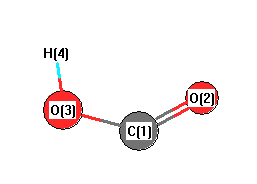Jump to
S1C2
Energy calculated at CCSD/TZVP
| | hartrees |
|---|
| Energy at 0K | -188.713585 |
| Energy at 298.15K | -188.714677 |
| HF Energy | -188.198494 |
| Nuclear repulsion energy | 63.258845 |
The energy at 298.15K was derived from the energy at 0K
and an integrated heat capacity that used the calculated vibrational frequencies.
Vibrational Frequencies calculated at CCSD/TZVP
| Mode Number |
Symmetry |
Frequency
(cm-1) |
Scaled Frequency
(cm-1) |
IR Intensities
(km mol-1) |
Raman Act
(Å4/u) |
Dep P |
Dep U |
|---|
| 1 |
A' |
3705 |
3536 |
29.00 |
|
|
|
| 2 |
A' |
1910 |
1823 |
334.12 |
|
|
|
| 3 |
A' |
1327 |
1267 |
0.65 |
|
|
|
| 4 |
A' |
1101 |
1051 |
201.23 |
|
|
|
| 5 |
A' |
620 |
592 |
36.68 |
|
|
|
| 6 |
A" |
566 |
541 |
130.41 |
|
|
|
Unscaled Zero Point Vibrational Energy (zpe) 4614.8 cm
-1
Scaled (by 0.9544) Zero Point Vibrational Energy (zpe) 4404.4 cm
-1
See section
III.C.1 List or set vibrational scaling factors
to change the scale factors used here.
See section
III.C.2
Calculate a vibrational scaling factor for a given set of molecules
to determine the least squares best scaling factor.
Geometric Data calculated at CCSD/TZVP
Point Group is Cs
Cartesians (Å)
| Atom |
x (Å) |
y (Å) |
z (Å) |
|---|
| C1 |
0.000 |
0.445 |
0.000 |
| O2 |
-1.060 |
-0.360 |
0.000 |
| O3 |
1.152 |
0.186 |
0.000 |
| H4 |
-0.739 |
-1.278 |
0.000 |
Atom - Atom Distances (Å)
| |
C1 |
O2 |
O3 |
H4 |
| C1 | | 1.3312 | 1.1813 | 1.8754 |
O2 | 1.3312 | | 2.2788 | 0.9728 | O3 | 1.1813 | 2.2788 | | 2.3920 | H4 | 1.8754 | 0.9728 | 2.3920 | |
 More geometry information
More geometry information
Calculated Bond Angles
| atom1 |
atom2 |
atom3 |
angle |
|
atom1 |
atom2 |
atom3 |
angle |
| C1 |
O2 |
H4 |
107.962 |
|
O2 |
C1 |
O3 |
130.081 |
Electronic energy levels
Charges, Dipole, Quadrupole and Polarizability
Jump to
S1C1
Energy calculated at CCSD/TZVP
| | hartrees |
|---|
| Energy at 0K | -188.716611 |
| Energy at 298.15K | -188.717677 |
| HF Energy | -188.199269 |
| Nuclear repulsion energy | 62.991226 |
The energy at 298.15K was derived from the energy at 0K
and an integrated heat capacity that used the calculated vibrational frequencies.
Vibrational Frequencies calculated at CCSD/TZVP
| Mode Number |
Symmetry |
Frequency
(cm-1) |
Scaled Frequency
(cm-1) |
IR Intensities
(km mol-1) |
Raman Act
(Å4/u) |
Dep P |
Dep U |
|---|
| 1 |
A' |
3867 |
3691 |
115.44 |
|
|
|
| 2 |
A' |
1948 |
1859 |
241.33 |
|
|
|
| 3 |
A' |
1278 |
1220 |
248.04 |
|
|
|
| 4 |
A' |
1096 |
1046 |
81.56 |
|
|
|
| 5 |
A' |
631 |
603 |
6.17 |
|
|
|
| 6 |
A" |
525 |
501 |
99.49 |
|
|
|
Unscaled Zero Point Vibrational Energy (zpe) 4672.8 cm
-1
Scaled (by 0.9544) Zero Point Vibrational Energy (zpe) 4459.8 cm
-1
See section
III.C.1 List or set vibrational scaling factors
to change the scale factors used here.
See section
III.C.2
Calculate a vibrational scaling factor for a given set of molecules
to determine the least squares best scaling factor.
Geometric Data calculated at CCSD/TZVP
Point Group is Cs
Cartesians (Å)
| Atom |
x (Å) |
y (Å) |
z (Å) |
|---|
| C1 |
0.000 |
0.409 |
0.000 |
| O2 |
-0.941 |
-0.551 |
0.000 |
| O3 |
1.167 |
0.259 |
0.000 |
| H4 |
-1.801 |
-0.115 |
0.000 |
Atom - Atom Distances (Å)
| |
C1 |
O2 |
O3 |
H4 |
| C1 | | 1.3443 | 1.1761 | 1.8756 |
O2 | 1.3443 | | 2.2582 | 0.9637 | O3 | 1.1761 | 2.2582 | | 2.9910 | H4 | 1.8756 | 0.9637 | 2.9910 | |
 More geometry information
More geometry information
Calculated Bond Angles
| atom1 |
atom2 |
atom3 |
angle |
|
atom1 |
atom2 |
atom3 |
angle |
| C1 |
O2 |
H4 |
107.572 |
|
O2 |
C1 |
O3 |
127.136 |
Electronic energy levels
Charges, Dipole, Quadrupole and Polarizability
